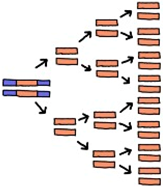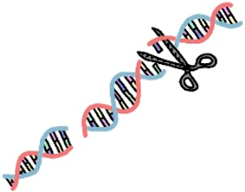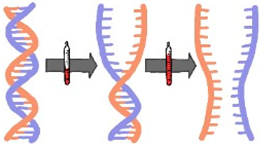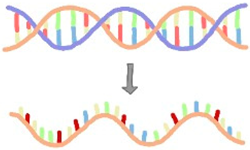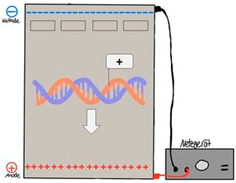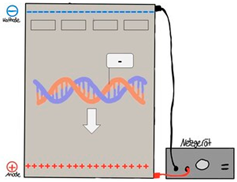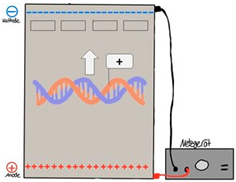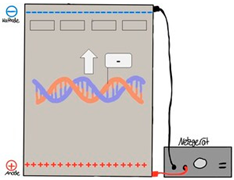Combining Virtual and Hands-on Lab Work in a Blended Learning Approach on Molecular Biology Methods and Lab Safety for Lower Secondary Education Students
Abstract
1. Introduction
2. Literature Review
2.1. Advantages and Disadvantages of Virtual Laboratories in Science Education
2.2. Authentic Real Laboratory Experiences Foster Scientific Interest
2.3. Exploring Blended Learning Concepts in Science Education
3. Research Question
- (i)
- Are blended learning concepts in out-of-school labs more effective in building declarative knowledge of laboratory safety and molecular biology compared to working solely in virtual or wet labs, or compared to regular teaching?
- (ii)
- Does combining virtual and wet labs in a blended learning concept reduce perceived authenticity?
- (iii)
- Is there a correlation between the perceived authenticity and knowledge gain in the areas of molecular biology and laboratory safety among lower secondary education students?
4. Methodology
4.1. Research Design
4.2. Study Sample
4.3. Measurement Instruments
4.4. Data Analysis
5. Results
6. Discussion and Conclusions
6.1. Blended Learning Concepts for Teaching Laboratory Safety Rules
6.2. Blended Learning Concepts for Teaching Molecular Biology Methods
Author Contributions
Funding
Institutional Review Board Statement
Informed Consent Statement
Data Availability Statement
Conflicts of Interest
Appendix A
| Scale | Declarative knowledge of molecular biology methods | |||
| Sample size | N = 405 | |||
| Sample | Secondary school students after their visit of a molecular biology out-of-school learning lab | |||
| Reliability | α = 0.77 | |||
| Item | Possible answers | Mean | Item-Rest correlation | α without item |
|
| 0.71 | 0.39 | 0.75 |
| ||||
| ||||
| ||||
|
| 0.61 | 0.31 | 0.77 |
| ||||
| ||||
| ||||
|
| 0.62 | 0.43 | 0.75 |
| ||||
| ||||
| ||||
|
| 0.48 | 0.45 | 0.75 |
| ||||
| ||||
| ||||
|
| 0.59 | 0.57 | 0.73 |
| ||||
| ||||
| ||||
|
| 0.54 | 0.38 | 0.76 |
| ||||
| ||||
| ||||
|
| 0.65 | 0.43 | 0.75 |
| ||||
| ||||
| ||||
|
| 0.54 | 0.60 | 0.72 |
| ||||
| ||||
| ||||
|
| 0.73 | 0.60 | 0.72 |
| ||||
| ||||
| ||||
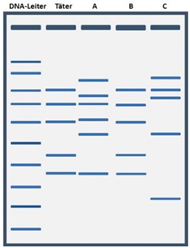 |
| N.A. | N.A. | N.A. |
| ||||
| ||||
| ||||
References
- Anderson, J. R., Grabowski, J., & Graf, R. (2001). Kognitive psychologie (3. Auflage, Spektrum Lehrbuch). Spektrum Akademischer Verlag. ISBN 978-3-8274-1024-5. [Google Scholar]
- Blanz, M. (2021). Forschungsmethoden und statistik für die soziale arbeit: Grundlagen und anwendungen (2nd ed.). W. Kohlhammer GmbH. [Google Scholar] [CrossRef]
- Bryant, A., Gieskes, K., & McGrann, R. (2009, October 18–21). The role of active learning through laboratory experimentation pertaining to memory retention in first-year engineering programs. 2009 39th IEEE Frontiers in Education Conference (pp. 1–6), San Antonio, TX, USA. [Google Scholar] [CrossRef]
- Caravias, V. (2018). Teachers’ conceptions and approaches to blended learning: A literature review. In Management Association (Ed.), Online course management: Concepts, methodologies, tools, and applications (pp. 974–997). IGI Global. [Google Scholar] [CrossRef]
- Cavas, B., & Koç, S. (2022). The effects of laboratory safety professional development seminars implemented on science teachers: Laboratory safety knowledge levels. Science Education International, 33(4), 438–448. [Google Scholar] [CrossRef]
- Caymaz, B. (2021). Secondary school students’ knowledge and views on laboratory safety. Journal of Science Learning, 4(3), 220–229. [Google Scholar] [CrossRef]
- Cronbach, L. J. (1951). Coefficient alpha and the internal structure of tests. Psychometrika, 16(3), 297–334. [Google Scholar] [CrossRef]
- Deci, E. L., & Ryan, R. M. (1993). Die Selbstbestimmungstheorie der Motivation und ihre Bedeutung für die Pädagogik. Zeitschrift für Pädagogik, 39(2), 223–238. [Google Scholar] [CrossRef]
- Döring, N., & Bortz, J. (2016). Forschungsmethoden und Evaluation in den Sozial-und Humanwissenschaften. Springer. [Google Scholar] [CrossRef]
- Engeln, K. (2004). Schülerlabors: Authentische, aktivierende Lernumgebungen als Möglichkeit, Interesse an Naturwissenschaften und Technik zu wecken (Vol. 36). Logos. [Google Scholar]
- Fieselmann, J., Annac, K., Erdsiek, F., Yilmaz-Aslan, Y., & Brzoska, P. (2022). What are the reasons for refusing a COVID-19 vaccine? A qualitative analysis of social media in Germany. BMC Public Health, 22(1), 846. [Google Scholar] [CrossRef]
- Frewer, L. J., Van Der Lans, I. A., Fischer, A. R. H., Reinders, M. J., Menozzi, D., Zhang, X., Van Den Berg, I., & Zimmermann, K. L. (2013). Public perceptions of agri-food applications of genetic modification—A systematic review and meta-analysis. Trends in Food Science & Technology, 30(2), 142–152. [Google Scholar] [CrossRef]
- Friedman, D. C., & Ellington, A. D. (2015). Industrialization of biology. ACS Synthetic Biology, 4(10), 1053–1055. [Google Scholar] [CrossRef]
- Gauthier, A. (2024). Game and simulation stimulate conceptual change about molecular emergence in different ways, with potential cultural implications. Education Sciences, 14(4), 366. [Google Scholar] [CrossRef]
- Gericke, N., Högström, P., & Wallin, J. (2023). A systematic review of research on laboratory work in secondary school. Studies in Science Education, 59(2), 245–285. [Google Scholar] [CrossRef]
- Glowinski, I. (2007). Schülerlabore im Themenbereich Molekularbiologie als Interesse fördernde Lernumgebungen. Christian-Albrechts-Universität. [Google Scholar]
- Gublo, K. I. (2003). A Laboratory Safety Trivia Game. Journal of Chemical Education, 80(4), 425. [Google Scholar] [CrossRef]
- Guerra-Carrillo, B., Katovich, K., & Bunge, S. A. (2017). Does higher education hone cognitive functioning and learning efficacy? Findings from a large and diverse sample. PLoS ONE, 12(8), e0182276. [Google Scholar] [CrossRef] [PubMed]
- Haberbosch, M., Vick, P., & Schaal, S. (in press). Navigating molecular biology education at the intermediate level: Content relevance & teachers’ challenges, self-efficacy, and knowledge. IJSE. in press.
- Hafer, J. (2021). Auf der Suche nach dem Präsenzgen in der Universitätslehre. Eine Spurensuche in den Präsenzdiskursen der letzten Dekade. In H.-W. Wollersheim, M. Karapanos, & N. Pengel (Eds.), Medien in der Wissenschaft-Bildung in der digitalen Transformation (Issue 78, pp. 47–58). Waxmann. [Google Scholar] [CrossRef]
- Hofstein, A., & Lunetta, V. N. (2004). The laboratory in science education: Foundations for the twenty-first century. Science Education, 88(1), 28–54. [Google Scholar] [CrossRef]
- Hughes, J., Thomas, R., & Scharber, C. (2006). Assessing Technology Integration: The RAT–Replacement, Amplification, and Transformation–Framework. In C. Crawford, R. Carlson, K. McFerrin, J. Price, R. Weber, & D. Willid (Eds.), Proceedings of SITE 2006–Society for Information Technology & Teacher Education International Conference (pp. 1616–1620). [Google Scholar]
- Itzek-Greulich, H., Flunger, B., Vollmer, C., Nagengast, B., Rehm, M., & Trautwein, U. (2015). Effects of a science center outreach lab on school students’ achievement—Are student lab visits needed when they teach what students can learn at school? Learning and Instruction, 38, 43–52. [Google Scholar] [CrossRef]
- Lave, J., & Wenger, E. (1991). Situated learning: Legitimate peripheral participation (1st ed.). Cambridge University Press. [Google Scholar] [CrossRef]
- Lynch, T., & Ghergulescu, I. (2017, March 6–8). Review of virtual labs as the emerging technologies for teaching stem subjects. 11th International Technology, Education and Development Conference (pp. 6082–6091), Valencia, Spain. [Google Scholar] [CrossRef]
- Makransky, G., Petersen, G. B., & Klingenberg, S. (2020). Can an immersive virtual reality simulation increase students’ interest and career aspirations in science? British Journal of Educational Technology, 51(6), 2079–2097. [Google Scholar] [CrossRef]
- Mercado, J., & Picardal, J. P. (2023). Virtual laboratory simulations in biotechnology: A systematic review. Science Education International, 34(1), 52–57. [Google Scholar] [CrossRef]
- Muenz, T. S., Schaal, S., Groß, J., & Paul, J. (2023). How a digital educational game can promote learning about sustainability. Science Education International, 34(4), 293–302. [Google Scholar] [CrossRef]
- Navarro, C., Arias-Calderón, M., Henríquez, C. A., & Riquelme, P. (2024). Assessment of student and teacher perceptions on the use of virtual simulation in cell biology laboratory education. Education Sciences, 14(3), 243. [Google Scholar] [CrossRef]
- Nephew, S., & Sunasee, R. (2021). An engaging and fun breakout activity for educators and students about laboratory safety. Journal of Chemical Education, 98(1), 186–190. [Google Scholar] [CrossRef]
- Pawek, C. (2009). Schülerlabore als interessefördernde außerschulische Lernumgebungen für Schülerinnen und Schüler aus der Mittel-und Oberstufe. Christian-Albrechts-Universität. [Google Scholar]
- Poensgen, F., Hohr, A., Vit, M., & Reiners, C. S. (2021). Gefahren virtuell begegnen. Nachrichten Aus Der Chemie, 69(10), 11–15. [Google Scholar] [CrossRef]
- Sahdra, B., & Thagard, P. (2003). Procedural knowledge in molecular biology. Philosophical Psychology, 16(4), 477–498. [Google Scholar] [CrossRef]
- Savvides, P. (2018). Teaching science lab safety: Are virtual simulations effective? Arizona State University. [Google Scholar]
- Schaal, S., Meissner, M., & Schaal, S. (2022). Reflexive Unterrichtspraxis in der Lehrkräftebildung—Fachdidaktische Reflexion im Lehr-Lern-Labor fördern. Lehrerbildung auf dem Prüfstand, 15(1), 5–25. [Google Scholar]
- Scharfenberg, F., & Bogner, F. X. (2010). Instructional efficiency of changing cognitive load in an out-of-school laboratory. International Journal of Science Education, 32(6), 829–844. [Google Scholar] [CrossRef]
- Scharfenberg, F., Bogner, F. X., & Klautke, S. (2007). Learning in a gene technology laboratory with educational focus: Results of a teaching unit with authentic experiments. Biochemistry and Molecular Biology Education, 35(1), 28–39. [Google Scholar] [CrossRef]
- Schäfers, M. S., Schmiedebach, M., & Wegner, C. (2020). Virtuelle Labore im Biologieunterricht: Auswirkungen von Labster auf die Selbsteinschätzung von Schülerinnen und Schülern. MedienPädagogik: Zeitschrift Für Theorie Und Praxis Der Medienbildung, 140–167. [Google Scholar] [CrossRef]
- Schüttler, T., Watzka, B., Girwidz, R., & Ertl, B. (2021). Die wirkung der authentizität von lernort und laborgeräten auf das situationale interesse und die relevanzwahrnehmung beim besuch eines naturwissenschaftlichen schülerlabors. Zeitschrift für Didaktik der Naturwissenschaften, 27(1), 109–125. [Google Scholar] [CrossRef]
- Strømme, T. A., & Mork, S. M. (2021). Students’ conceptual sense-making of animations and static visualizations of protein synthesis: A sociocultural hypothesis explaining why animations may be beneficial for student learning. Research in Science Education, 51(4), 1013–1038. [Google Scholar] [CrossRef]
- Sweller, J., Van Merriënboer, J. J. G., & Paas, F. (2019). Cognitive architecture and instructional design: 20 years later. Educational Psychology Review, 31(2), 261–292. [Google Scholar] [CrossRef]
- Sweller, J., Van Merrienboer, J. J. G., & Paas, F. G. W. C. (1998). Cognitive architecture and instructional design. Educational Psychology Review, 10(3), 251–296. [Google Scholar] [CrossRef]
- Tang, C. M., & Chaw, L. Y. (2016). Digital literacy: A prerequisite for effective learning in a blended learning environment? The Electronic Journal of e-Learning, 14(1), 54–65. [Google Scholar]
- Tempelaar, D. T., Rienties, B., & Giesbers, B. (2009). Who profits most from blended learning? Industry and Higher Education, 23(4), 285–292. [Google Scholar] [CrossRef]
- Thisgaard, M., & Makransky, G. (2017). Virtual learning simulations in high school: Effects on cognitive and non-cognitive outcomes and implications on the development of stem academic and career choice. Frontiers in Psychology, 8, 805. [Google Scholar] [CrossRef] [PubMed]
- Vahdatikhaki, F., Friso-van Den Bos, I., Mowlaei, S., & Kollöffel, B. (2024). Application of gamified virtual laboratories as a preparation tool for civil engineering students. European Journal of Engineering Education, 49(1), 164–191. [Google Scholar] [CrossRef]
- Wu, K., Jin, X., & Wang, X. (2021). Determining university students’ familiarity and understanding of laboratory safety knowledge—A case study. Journal of Chemical Education, 98(2), 434–438. [Google Scholar] [CrossRef]
- Yu, A., Wisinski, J., Osmundson, T., Sanderfoot, A., Cooper, S., & Klein, J. (2022). Instructional innovations in college-level molecular bioscience labs during the pandemic-induced shift to online learning. Education Sciences, 12(4), 230. [Google Scholar] [CrossRef]
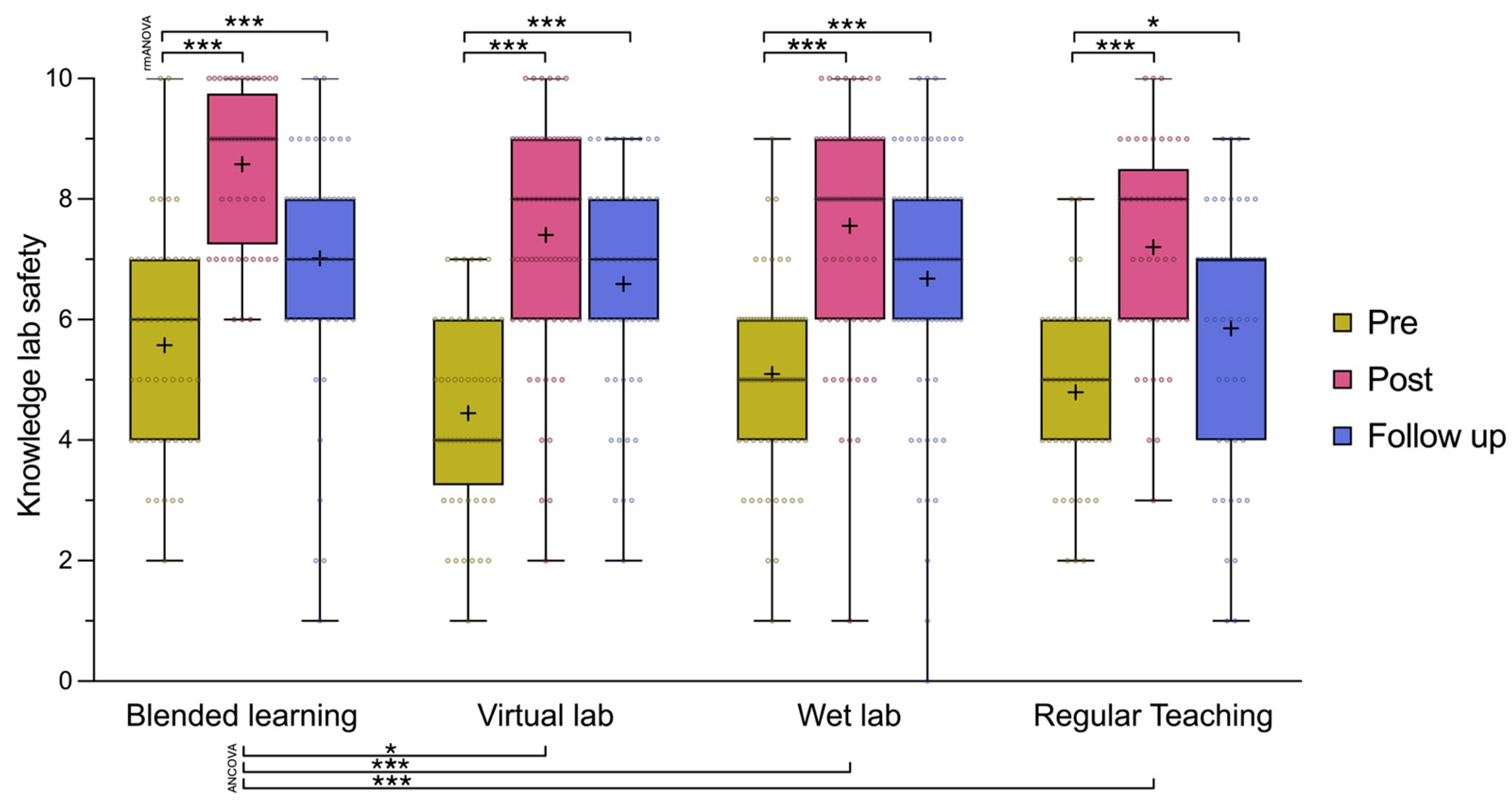
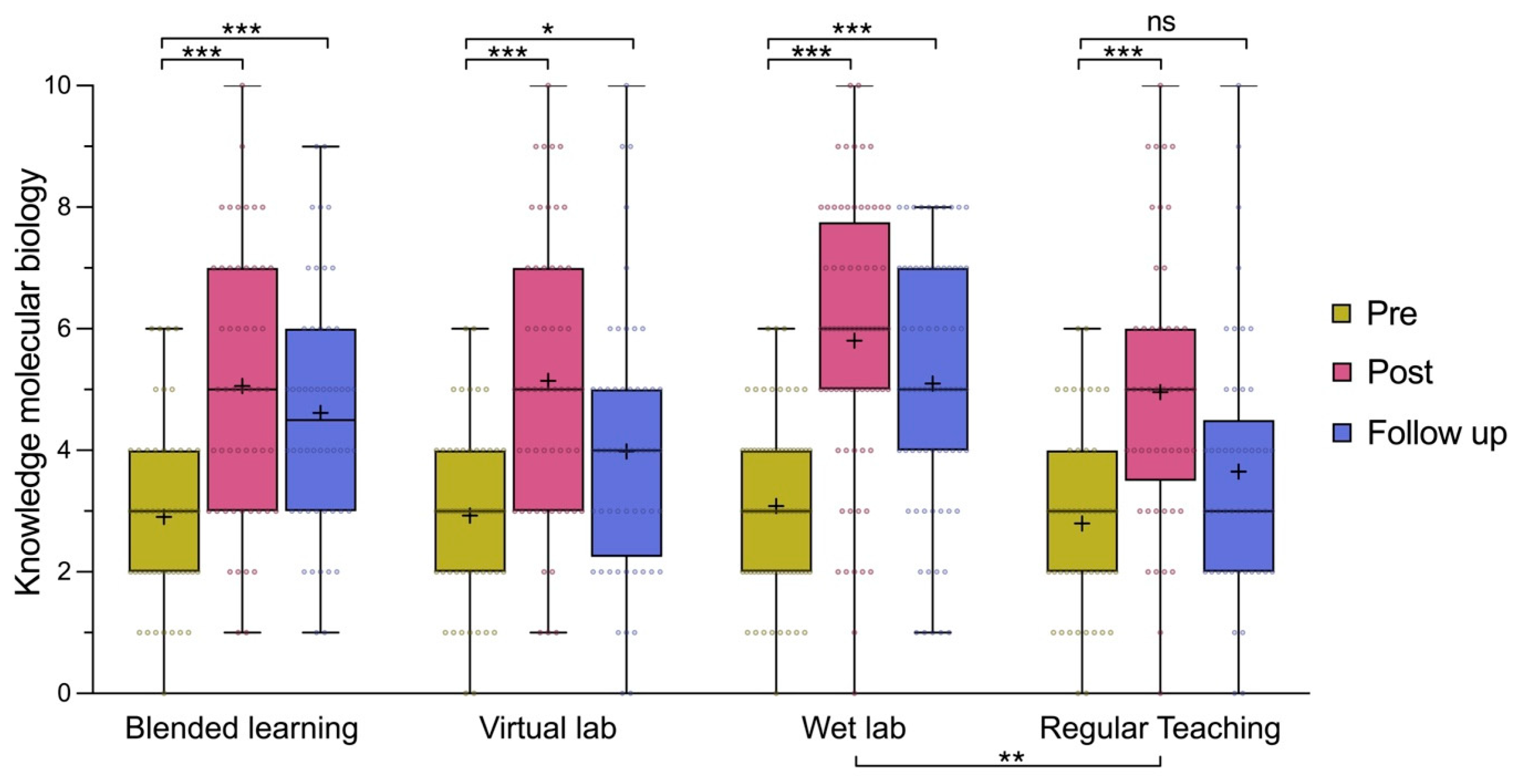
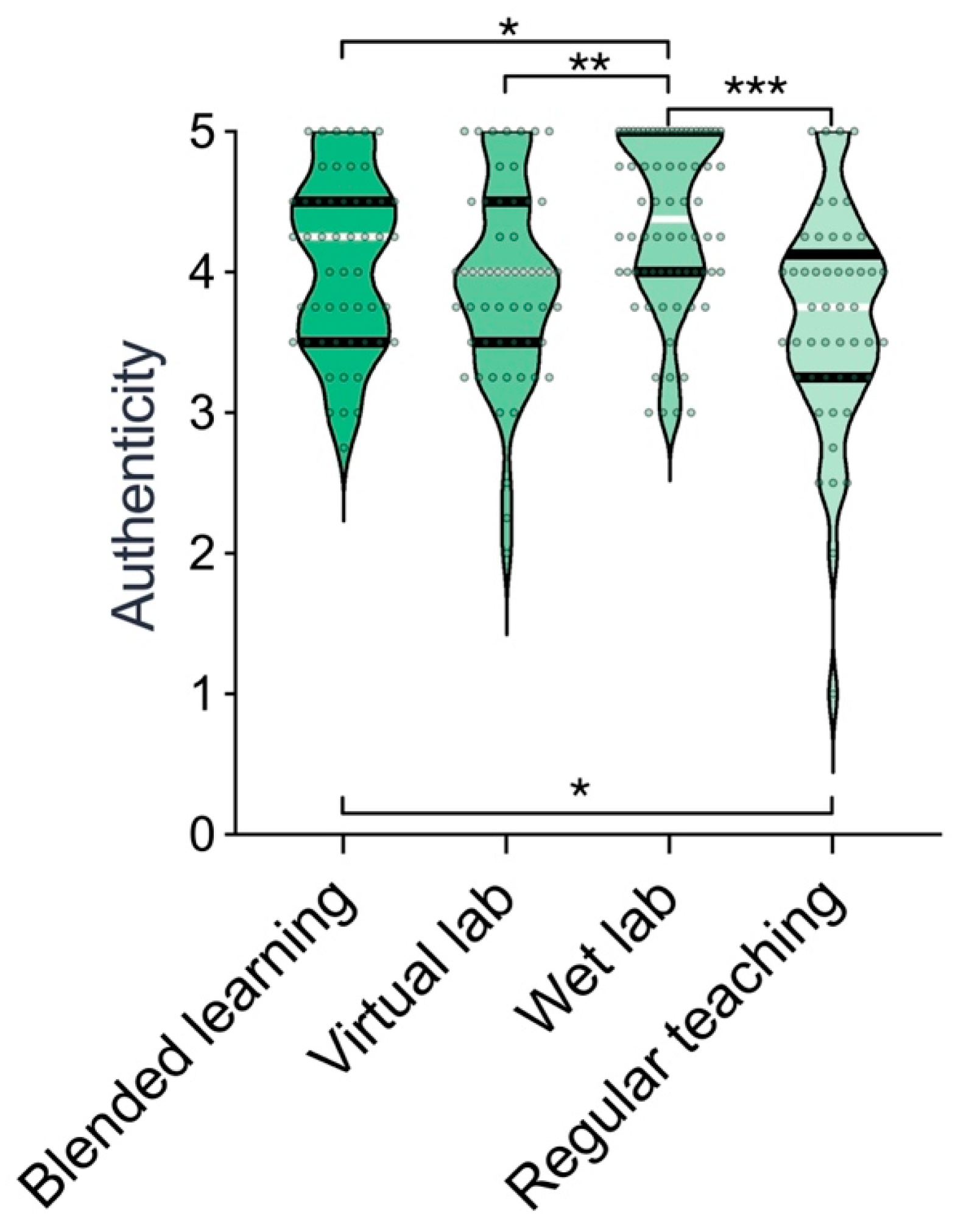
| BL | VL | WL | RT | |
|---|---|---|---|---|
| Preparation Lesson | ||||
| Getting to know the structure of DNA by building a three-dimensional model in small groups | x | x | x | x |
| Lab Safety | ||||
| Putting on lab coats | x | - | x | - |
| Teacher emphasizes lab safety for everyone and its impact on experiment outcomes | x | x | x | x |
| Getting to know hazard pictograms | x (as in VL) | x (DS) | x (TL) | x (TL) |
| Determining pH and neutralization of acids | x (as in WL) | x (DS) | x (HO) | x (TL) |
| Proper handling of safety equipment (goggles, lab coats, etc.) | x (as in VL) | x (DS) | x (TL) | x (TL) |
| Safety measures for unwanted chemical reactions | x (as in WL) | x (DS) | x (HO) | x (TL) |
| Introduction to important locations (and their functions) (e.g.,: fire extinguishers) | x (TL) | x (DS) | x (HO) | x (TL) |
| Molecular biology | ||||
| Presenting the fictional murder case | x | x | x | x |
| Presentation of theory of PCR through an explanatory video | x | x | x | x |
| PCR application | x (as in VL) | x (DS) | x (TL) | x (WS) |
| Presentation of theory of gel electrophoresis through an explanatory video | x | x | x | x |
| Gel electrophoresis application | x (as in VL) | x (DS) | x (TL) | x (WS) |
| Treat-ment | Lab Safety Knowledge Pre | Lab Safety Knowledge Post | Lab Safety Knowledge Follow-Up | Molecular Biology Knowledge Pre | Molecular Biology Knowledge Post | Molecular Biology Knowledge Follow-Up | Authen-ticity |
|---|---|---|---|---|---|---|---|
| BL | 5.58 ± 1.76 | 8.58 ± 1.23 | 7.02 ± 1.95 | 2.90 ± 1.46 | 5.06 ± 2.19 | 4.62 ± 1.94 | 4.06 ± 0.618 |
| WL | 5.03 ± 1.39 | 7.56 ± 1.81 | 6.68 ± 2.07 | 3.03 ± 1.34 | 5.81 ± 2.18 | 5.10 ± 2.07 | 4.35 ± 0.635 |
| VL | 4.45 ± 1.54 | 7.71 ± 1.58 | 6.59 ± 1.80 | 2.93 ± 1.39 | 5.14 ± 2.24 | 3.98 ± 2.11 | 3.90 ± 0.694 |
| RT | 4.80 ± 1.43 | 7.20 ± 1.70 | 5.86 ± 2.12 | 2.80 ± 1.51 | 4.96 ± 2.24 | 3.65 ± 2.07 | 3.66 ± 0.783 |
Disclaimer/Publisher’s Note: The statements, opinions and data contained in all publications are solely those of the individual author(s) and contributor(s) and not of MDPI and/or the editor(s). MDPI and/or the editor(s) disclaim responsibility for any injury to people or property resulting from any ideas, methods, instructions or products referred to in the content. |
© 2025 by the authors. Licensee MDPI, Basel, Switzerland. This article is an open access article distributed under the terms and conditions of the Creative Commons Attribution (CC BY) license (https://creativecommons.org/licenses/by/4.0/).
Share and Cite
Haberbosch, M.; Deiters, M.; Schaal, S. Combining Virtual and Hands-on Lab Work in a Blended Learning Approach on Molecular Biology Methods and Lab Safety for Lower Secondary Education Students. Educ. Sci. 2025, 15, 123. https://doi.org/10.3390/educsci15020123
Haberbosch M, Deiters M, Schaal S. Combining Virtual and Hands-on Lab Work in a Blended Learning Approach on Molecular Biology Methods and Lab Safety for Lower Secondary Education Students. Education Sciences. 2025; 15(2):123. https://doi.org/10.3390/educsci15020123
Chicago/Turabian StyleHaberbosch, Maximilian, Marvin Deiters, and Steffen Schaal. 2025. "Combining Virtual and Hands-on Lab Work in a Blended Learning Approach on Molecular Biology Methods and Lab Safety for Lower Secondary Education Students" Education Sciences 15, no. 2: 123. https://doi.org/10.3390/educsci15020123
APA StyleHaberbosch, M., Deiters, M., & Schaal, S. (2025). Combining Virtual and Hands-on Lab Work in a Blended Learning Approach on Molecular Biology Methods and Lab Safety for Lower Secondary Education Students. Education Sciences, 15(2), 123. https://doi.org/10.3390/educsci15020123






